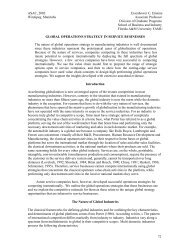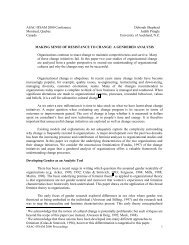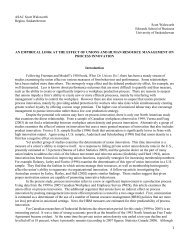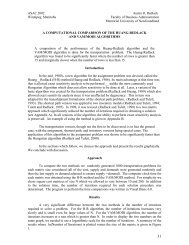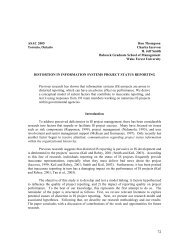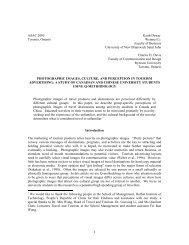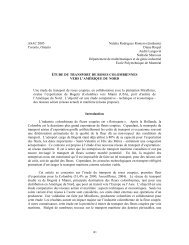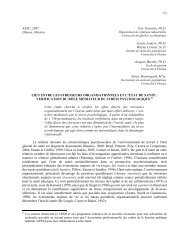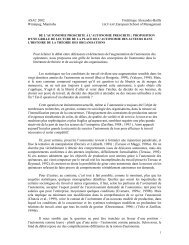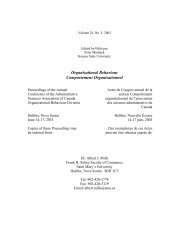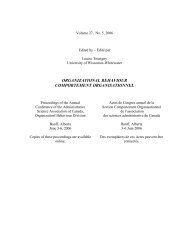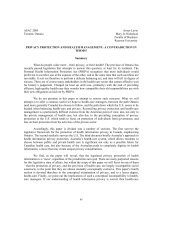ASAC 2010 Regina, Saskatchewan Xiaoyan Xing Faculty of ...
ASAC 2010 Regina, Saskatchewan Xiaoyan Xing Faculty of ...
ASAC 2010 Regina, Saskatchewan Xiaoyan Xing Faculty of ...
Create successful ePaper yourself
Turn your PDF publications into a flip-book with our unique Google optimized e-Paper software.
<strong>ASAC</strong> <strong>2010</strong><br />
<strong>Regina</strong>, <strong>Saskatchewan</strong><br />
<strong>Xiaoyan</strong> <strong>Xing</strong><br />
<strong>Faculty</strong> <strong>of</strong> Management<br />
Laurentian University, Canada<br />
Ping Yang<br />
Capital Institute <strong>of</strong> P.E., China<br />
Norm O’Reilly<br />
David Falk Center for Sport Management<br />
Syracuse University<br />
PARTICIPANT MOTIVATIONS TO ATTEND AN AEROBICS EVENT IN CHINA:<br />
SIMILARITIES AND DIFFERENCES ACROSS SEGMENTS AND PREDICTORS OF EVENT<br />
SATISFACTION AND FUTURE ATTENDANCE INTENTION<br />
A survey was conducted among participants (n=174) at a national<br />
Aerobics event in China. Beard and Ragheb’s (1983) Leisure<br />
Motivation Scale was revised for the cultural and sport contexts.<br />
Results reveal six motivational factors for participation. The findings<br />
point to culture and subculture characteristics in sport participation.<br />
The International Association for the Study <strong>of</strong> Obesity (IASO) notes the increasingly sedentary<br />
lifestyles <strong>of</strong> youth in developed countries around the globe as supported by the drastic rise in obesity and<br />
diabetes (IASO, 2008). These trends, and others, have led governments and organizations to increase their<br />
efforts to promote active lifestyles (James & Johnston, 2004). Consequently, research in related areas <strong>of</strong><br />
health, including sport participation, has been drawn upon to develop polices, programs and strategies.<br />
Although sport varies in its composition and culture from country to country, promoting sport<br />
participation through policy initiatives such as sport for all is an important global effort that is sponsored<br />
and endorsed by major international sports organizations (e.g., International Olympic Committee), health<br />
organizations (e.g., World Health Organization), and national governments (cf. International Olympic<br />
Committee, 2009; World Health Organization, 2003). In North America, nearly 85 million <strong>of</strong> the 205.9<br />
million adults in the United States participated in sport and physical activities and spent an estimated<br />
US$73.3 billion on sport consumption in 2002 (U.S. Census Bureau, 2004-2005), while in Canada, 7.3<br />
million people participate in sport spending CDN$15.8 billion annually on related consumption (Statistics<br />
Canada, 2008; Heritage Canada, 2008). These numbers demonstrate the large consumer base for<br />
participatory sport events which exists in North America and, by extension, developed countries <strong>of</strong> the<br />
world. Coupled with government and organization support (James & Johnston, 2004), opportunities to<br />
increase sport participation are considerable. In this regard, it is essential that the governments and<br />
organizations charged with developing and delivering sport policies, programs and events in order to<br />
increase sport participation in their respective jurisdictions must cater to the needs <strong>of</strong> current and potential<br />
participants (i.e., a marketing approach). Indeed, past research has empirically demonstrated that sport<br />
programs adapted to target groups with different skill levels and behavioral characteristics are conducive<br />
to enhance participation and deliver the physical, social, and psychological benefits associated with sport<br />
participation (Green, 1997).<br />
1
A variety <strong>of</strong> strongly supported theories <strong>of</strong> human behavior exist that outline why and how<br />
certain actions occur. As suggested by Berger et al. (2008) in their work on urban youth sport<br />
participation, future research and strategic intervention need to build on previous strategic frameworks <strong>of</strong><br />
social marketing (i.e., behavior change). One such theory (see Rothschild, 1999) outlines that achieving<br />
behavior change in the target individual is constrained by three factors: motivation, opportunity and<br />
ability. One <strong>of</strong> the eight target market scenarios identified by Rothschild is when the target is not<br />
motivated to partake in the sought behavior but has the opportunity and the ability to behave, so<br />
motivation is the key driver. Adapting this scenario to the case <strong>of</strong> sport participation behavior, implies<br />
that when (i) the available facilities and external environment are conducive to sport participation<br />
(‘opportunity’) and (ii) the support network – parents, peers, coaches, teachers, etc. – to participate are in<br />
place (‘ability’), the participant’s (or potential participant’s) motivation to behave becomes the pivotal<br />
aspect. Thus, enhancing motivation to participate in sport is the general area <strong>of</strong> focus <strong>of</strong> this research<br />
paper.<br />
In addition to the theoretical justification to look at sport participation from a marketing<br />
perspective, there is a practitioner argument as well. As noted by Green (1997; 2005), in order to develop<br />
effective sport programs and events, it is necessary to understand the motivations that drive sport<br />
participation. Previous research has provided considerable knowledge in the area. A substantial amount <strong>of</strong><br />
work has been done that examines why people travel to attend sport events (e.g., Crompton & McKay,<br />
1997; Green, & Chalip, 1998; Nadeau et al., 2008) and pursue leisure activities (e.g., Beard & Ragheb,<br />
1983; Manfredo & Driver, 1996; Mannell & Iso-Ahola, 1987; Skar, Odden, & Vistad, 2008). Notably, the<br />
work <strong>of</strong> Beard and Ragheb is considered seminal in the area and much follow-up research and application<br />
has resulted. Based on an extensive review <strong>of</strong> the previous work, they (Beard & Ragheb, 1983) grouped<br />
leisure motivations along four dimensions: intellectual motivation, social motivation, stimulus-avoidance<br />
motivation, and competence-mastery motivation. The intellectual dimension posits that people engage in<br />
leisure activities because these activities allow them to learn, to discover, to imagine, and to create. In<br />
terms <strong>of</strong> the social dimension, it is believed that leisure activities meet the needs for friendship and the<br />
esteem <strong>of</strong> others. Regarding the competence-mastery dimension, participation in leisure activities renders<br />
a sense <strong>of</strong> achievement, challenge, mastery, and competition. Finally, the stimulus-avoidance dimension<br />
has to do with escaping from life situations and social contacts, and to seek rest and to unwind.<br />
These dimensions are germane to the reasons why people participate in sport events (Filo, Funk,<br />
& O’Brien, 2008) and have been extensively used across a wide variety <strong>of</strong> leisure activities and settings<br />
(Kim & Chalip, 2004; Mohsin, 2005; Staempfi, 2007). However, one limitation <strong>of</strong> the Beard and<br />
Ragheb’s dimensional leisure motivation structure is that it was derived from studies taking place in<br />
Western cultures (i.e. Europe and North America), leaving some uncertainty around its applicability in the<br />
rapidly developing Eastern cultures. There exists empirical evidence supporting that it may not be directly<br />
applicable in these contexts. For example, Kay and Mannell (1990) found six factors when administering<br />
the scale to a group <strong>of</strong> female Chinese Canadians whereas a five solution structure was obtained when<br />
assessing the leisure motivations <strong>of</strong> Japanese managers in the U.K (Murray & Nakajima, 1999). Based on<br />
this uncertainty, this paper seeks to better understand participants’ motivation to attend a sport event in an<br />
Eastern culture.<br />
2
Research Focus<br />
Currently, a gap exists in the sport management literature around participant motivations and<br />
compositions (segments) in leisure or recreational sport in non-Western countries. As outlined in the<br />
introduction, in order to understand why participants in Eastern cultures participate in sport, a requisite<br />
step is to identify the motives for participation. Specifically, this research will seek 1) to expand our<br />
understanding <strong>of</strong> the various motivations <strong>of</strong> sport participation in Eastern cultures, (2) from a market<br />
segmentation perspective, to compare motivational characteristics across group participants, and (3) to<br />
identify key factors that affect participation satisfaction and future attendance intention to a sport event in<br />
an Eastern culture. In order to address these three issues, this study will survey the motivations,<br />
identification with a sport subculture, satisfaction levels, intention for future attendance, and level <strong>of</strong><br />
physical activeness <strong>of</strong> the participants in an aerobics competition series in China. Three particular<br />
research questions are put forward.<br />
1. What are the motives and dimensions for participants who had decided to attend an aerobics<br />
event in an Eastern culture (China)<br />
2. What are the similarities and differences in sport subculture identification, participation<br />
motivations, and physical activeness level <strong>of</strong> the participants competing in different categories (or<br />
segments)<br />
3. How does identification with the aerobics subculture, motivational dimensions, and physical<br />
activeness level affect the participants’ satisfaction toward the event, and their intent to attend the<br />
event in the future<br />
Method<br />
The methodology followed is described here, including descriptions <strong>of</strong> the event, its participants<br />
and the measures used to address the three research questions.<br />
The event. The Chinese National Aerobics Competition is an event that has been held annually<br />
since 2003. It is sanctioned and organized by the Chinese Aerobics Association in order to promote<br />
grassroots participation in aerobics. Qualification events at the local and regional levels are held from<br />
September to December each year. The finalists then are able to enter the national competition which is<br />
held annually in late December. The national event typically draws around 1,500 participants competing<br />
in the four categories <strong>of</strong> middle school students, college students, employees, and senior.<br />
Participants. Participants were recruited for this study by the second author. In total, 174 participants<br />
in the regional qualification event in Beijing took part in the study. The Beijing event was held in 2009,<br />
as a qualifying event for the 6 th National Aerobics Competition. The participants were largely female<br />
(84.5%) with ages ranging from 11 years to 68 years (Mean=30StdDev=14.5). Thirty one participants<br />
were middle school student, 35 college students, 65 employees, and 41 seniors. The sample is considered<br />
representative because the demographic characteristics resemble the population attending the event.<br />
Measurements. Beard and Ragheb’s (1983) Leisure Motivation Scale was adapted for an aerobics<br />
event in China. This adaptation involved three steps. First, the 48 items in the Leisure Motivation Scale<br />
were translated to Chinese by the first author who is bilingual. Second, the second author who is also<br />
bilingual reviewed the translation to make sure that the translation was <strong>of</strong> high quality English and<br />
idiomatic in Chinese. Disagreements were fully discussed and the translations were revised until<br />
3
consensus was reached. Second, the authors examined each item to assess its suitability for describing the<br />
Chinese participants’ motives. Items deemed inappropriate were removed. Items not included in Beard<br />
and Ragheb’s scale but that were important and salient in describing the Chinese participants’ motivations<br />
were added and worded in a consistent fashion to the survey and the event. Third, the items were<br />
reviewed by two aerobic experts in China, who were instructed to assess whether the items captured the<br />
meanings sought and that they were applicable for the Chinese aerobics participants. Items deemed<br />
inappropriate by both experts were removed.<br />
The resulting scale included 6 items for the intellectual component, 6 items for the social<br />
component, and 9 items for the competence-mastery component. Since participation in sport events<br />
differs from engagement in leisure activities, 4 items from Beard and Ragheb’s stimulus-avoidance<br />
component were included to reflect the escape/adjustment part <strong>of</strong> the component. Two additional<br />
components arose from event, sport, and cultural contexts: 3 items form a sport-specific component that<br />
assesses the extent to which the participants are motivated to attend the event because <strong>of</strong> their relationship<br />
with aerobics as a sport, and 3 items consist <strong>of</strong> a group representation component that assesses the extent<br />
to which the participants are motivated to attend the event because the participation enables them to<br />
represent their respective organization. All <strong>of</strong> these items are depicted in Table 1 below.<br />
Table 1 List <strong>of</strong> motivational items<br />
Component/Item<br />
Intellectual<br />
to expand my interests.<br />
to be creative.<br />
to use my imagination.<br />
to make things more meaningful to me.<br />
to expand my knowledge.<br />
to learn about myself.<br />
Competence-Mastery<br />
to gain a feeling <strong>of</strong> achievement.<br />
to see what my abilities are.<br />
to challenge my abilities.<br />
to test my skill and ability in aerobics.<br />
to be active.<br />
to develop physical skills and abilities.<br />
to keep in shape physically.<br />
to develop physical fitness.<br />
to exercise.<br />
Aerobics<br />
because I like the sport <strong>of</strong> aerobics.<br />
because aerobics is easy to learn.<br />
because aerobics are not demanding on the<br />
physical skills.<br />
Component/Item<br />
Social<br />
to gain a feeling <strong>of</strong> belonging.<br />
to gain other’s respect.<br />
because attending the event and winning prizes will<br />
make others think highly <strong>of</strong> me.<br />
to meet new and different people.<br />
to build friendships with others.<br />
Because it is fun to be with a large group <strong>of</strong> people.<br />
Adjustment/Escape<br />
to relax mentally.<br />
to enrich my life.<br />
to avoid the hustles and bustles <strong>of</strong> daily activities.<br />
because preparing the event <strong>of</strong>fers me a justifiable<br />
excuse not to work/study.<br />
Group Representation<br />
to bring glory to my organization.<br />
because I represent my organization/school<br />
to win prizes.<br />
In order to gauge the participants’ sport subculture identification, two sub-constructs (aerobics<br />
subculture self identity and aerobics subculture social identity) were measured. Five items from Shamir’s<br />
4
(1992) Leisure Identity Salience scale were used to measure the participants’ aerobics subculture self<br />
identity. The participants were asked to rate, on a scale from 1 to 7, whether practicing aerobics is<br />
important to their self-feeling, affirms their values, allows them to express themselves, enables them to<br />
realize their aspirations, and contributes to their self-esteems. Four items from Callero’s (1985) Social<br />
Commitment Scale were included to measure the participants’ social identity <strong>of</strong> practicing aerobics. The<br />
participants were asked to rate their agreement with four statements on a 7-point scale with 1 being<br />
strongly disagree and 7 being strongly agree. The four statements were: (i) people think that aerobics is<br />
important to me, (ii) it is important to my friends and relatives that I continue to practice aerobics, (iii)<br />
many people would probably be disappointed if I just decided to stop practicing aerobics, and (iv) many<br />
<strong>of</strong> the people that I know expect me to continue practicing aerobics. Finally, Voss, Parasuraman, and<br />
Grewal’s (1998) four-item satisfaction scale was used to measure the participants’ satisfaction toward the<br />
event. The participants were asked to report the average time (no less than 30 minutes) <strong>of</strong> exercise each<br />
week and practicing aerobics each week. Also included in the survey were questions that seek to learn<br />
participants’ intentions to attend the event next year and their demographic characteristics.<br />
Data analysis. Exploratory Factor Analyses (EFA) were conducted to test the dimensionality <strong>of</strong><br />
the participation motives. ANOVA analyses were applied to compare the differences across participants<br />
groups. And regression analyses with stepwise methods were used to test effects <strong>of</strong> identification with the<br />
sport, participation motivations, and physical activeness level on satisfaction toward the event, and future<br />
attendance intention.<br />
Results<br />
Findings associated with each research question are presented in this section.<br />
Participation Motivations. The first research question considers the participation motives and<br />
dimensions <strong>of</strong> these motives to attend the aerobics event. The descriptive statistics <strong>of</strong> the motives were<br />
first determined. Further, given the relatively small sample size (n=174, including questionnaires with<br />
missing values) in relation to the number <strong>of</strong> motive items (31), the dimensionality <strong>of</strong> each <strong>of</strong> the<br />
motivation components was examined individually. EFA, with Varimax rotations and Eigenvalue greater<br />
than 1, was used to examine whether items in each component were loaded on the dimension as expected.<br />
If the items were loaded on more than one dimension, an additional EFA was conducted to group the<br />
items. The choices <strong>of</strong> groupings were guided by literature in sport consumption, the content <strong>of</strong> the items,<br />
and the results <strong>of</strong> the analysis. The findings are shown below in Table 2.<br />
Table 2 Results about participation motivations<br />
Component/Item Means Loadings<br />
Intellectual<br />
to expand my interests.<br />
to be creative.<br />
to use my imagination.<br />
to make things more meaningful to me.<br />
to expand my knowledge.<br />
to learn about myself.<br />
6.29<br />
5.36<br />
4.79<br />
6.19<br />
6.12<br />
5.01<br />
.588<br />
.740<br />
.817<br />
.729<br />
.636<br />
.802<br />
Social<br />
to gain a feeling <strong>of</strong> belonging.<br />
to gain other’s respect.<br />
4.36<br />
4.20<br />
.795<br />
.789<br />
Eigenvalue: 3.140<br />
% <strong>of</strong> Variance:<br />
52.326<br />
Alpha: .816<br />
Eigenvalue: 3.792<br />
% <strong>of</strong> Variance:<br />
63.193<br />
5
ecause attending the event and winning prizes will make<br />
others think highly <strong>of</strong> me.<br />
to meet new and different people.<br />
to build friendships with others.<br />
because it is fun to be with a large group <strong>of</strong> people.<br />
Competence-Mastery<br />
to gain a feeling <strong>of</strong> achievement.<br />
to see what my abilities are.<br />
to challenge my abilities.<br />
to test my skill and ability in aerobics.<br />
to be active.<br />
to develop physical skills and abilities.<br />
to keep in shape physically.<br />
to develop physical fitness.<br />
to exercise.<br />
Group Representation<br />
to bring glory to my organization.<br />
because I represent my organization/school<br />
to win prizes.<br />
Sport and Life Enjoyment<br />
to relax mentally.<br />
to enrich my life.<br />
because I like the sport <strong>of</strong> aerobics.<br />
Sport and Negative Escape<br />
to avoid the hustles and bustles <strong>of</strong> daily activities.<br />
because preparing the event <strong>of</strong>fers me a justifiable excuse not<br />
to work/study.<br />
because aerobics is easy to learn.<br />
because aerobics are not demanding on the physical skills.<br />
3.75<br />
4.82<br />
5.58<br />
5.35<br />
4.79<br />
5.52<br />
5.96<br />
4.95<br />
5.94<br />
6.25<br />
5.39<br />
5.94<br />
6.40<br />
5.56<br />
3.65<br />
3.20<br />
4.84<br />
6.20<br />
6.34<br />
1.99<br />
1.59<br />
2.40<br />
2.80<br />
.794<br />
.849<br />
.760<br />
.780<br />
.620<br />
.801<br />
.736<br />
.778<br />
.865<br />
.782<br />
.712<br />
.791<br />
.744<br />
.658<br />
.821<br />
.847<br />
.711<br />
.862<br />
.703<br />
.767<br />
.641<br />
.791<br />
.788<br />
Alpha: .882<br />
Eigenvalue: 5.220<br />
% <strong>of</strong> Variance:<br />
58.004<br />
Alpha: .899<br />
Eigenvalue: 1.825<br />
% <strong>of</strong> Variance:<br />
60.824<br />
Alpha: .676<br />
Eigenvalue: 1.744<br />
% <strong>of</strong> Variance:<br />
58.140<br />
Alpha: .614<br />
Eigenvalue: 2.246<br />
% <strong>of</strong> Variance:<br />
56.151<br />
Alpha: .738<br />
The results presented in Table 1 support that three motivational components (intellectual, social,<br />
and competence-mastery) are consistent with the Beard and Ragheb’ (1983) conceptualization. Six items<br />
in the intellectual motivation component loaded on one dimension with factor loadings ranging from .588<br />
to .817. The items had high internal consistency (Cronbach’s alpha=.816), and explained 52.3% <strong>of</strong> the<br />
variance. These results support that event participants attended the event, in part, to seek intellectual<br />
significance such as being creative, stimulating imagination, expanding interest and knowledge, and<br />
creating meanings through activities associated with attending the event. Six items in the social<br />
motivation component loaded on one dimension with factor loadings ranging from .760 to .849. The<br />
items had satisfactory internal consistency (Cronbach’s alpha=.882), and explained 63.2% <strong>of</strong> the variance.<br />
In this case, the results support that one <strong>of</strong> the key reasons why participants were attracted to the event is<br />
because it enabled them to socialize with others through making friends, and meeting people, and to<br />
reinforce self-esteem through achieving a sense <strong>of</strong> belongingness and gaining respects. Nine items in the<br />
competency-mastery motivation component loaded on one dimension with factor loadings ranging<br />
from .620 to .865. The items had satisfactory internal consistency (Cronbach’s alpha=.899), and<br />
explained 58.0% <strong>of</strong> the variance. An examination <strong>of</strong> the item contents shows that the study respondents<br />
believed that they were able to test their skill and ability in aerobics through participating in the event.<br />
The acquirement <strong>of</strong> these skills rendered a feeling <strong>of</strong> mastery and the competency developed was closely<br />
6
associated with one’s physical fitness level. In other words, the respondents were oriented to the healthy<br />
benefits in mastering aerobic skills and developing physical abilities when attending the event.<br />
The three items in the group representation motivation component loaded as expected. The factor<br />
loadings ranged from .658 to .847. The items explained 60.8% <strong>of</strong> the variance. Nonetheless, the items did<br />
not achieve satisfactory internal consistency reliability (Cronbach’s alpha=.676). In general terms, these<br />
results support that participants were motivated to attend the event because it allows them to represent<br />
their group and boost group esteem through winning prizes.<br />
The aerobics component and the adjustment/escape component were found to form two new<br />
dimensions. The dimensionalities <strong>of</strong> these items were tested both separately and together (i.e., items for<br />
both dimensions were entered in one EFA). Both methods yielded the same results. Only the results from<br />
the individual EFAs were presented in Table 2. The first derivative dimension includes the reasons<br />
participants attended the event: (i) to relax mentally, (ii) to enrich life, and (iii) because one likes the sport<br />
<strong>of</strong> aerobics. A close examination <strong>of</strong> the item contents reveals that this dimension is based on the<br />
enjoyment <strong>of</strong> practicing aerobics and the activity as a beneficial addition in one’s life. This dimension<br />
was thus named sport and life enjoyment. The factor loadings <strong>of</strong> the three items range from .703 to .711.<br />
They explain 58.1% <strong>of</strong> the variance. However, their internal consistency liability is less than satisfactory<br />
(Cronbach’s alpha=.614).<br />
The second derivative dimension includes four items why participants attend the event, which are:<br />
(i) to avoid the hustles and bustles <strong>of</strong> daily activities, (ii) because preparing for the event <strong>of</strong>fers one a<br />
justifiable excuse not to work and/or study, (iii) because aerobics is easy to learn, and (iv) because<br />
aerobics are not physically demanding. This factor was named sport and negative escape which is the<br />
opposite to the enjoyment dimension which denotes that one approaches sport in order to enrich life rather<br />
than use sport as an escape from life. The factor loadings <strong>of</strong> the four items range from .641 to .791, and<br />
explain 56.2% <strong>of</strong> the variance. Their internal consistency reliability is somewhat poor (Cronbach’s<br />
alpha=.738). It is noteworthy that the means <strong>of</strong> the four items were all below the 3.5 mid-point ranging<br />
from 1.99 to 2.80, meaning that the participants, on average, disagree with both the statements that (i)<br />
they attended the event for the purpose <strong>of</strong> escape and (ii) they chose aerobics because it is easy and not<br />
physically demanding.<br />
Group differences. The second research question sought to identify the similarities and<br />
differences in sub-culture identification, participation motivations, and physical activeness level for the<br />
participants competing in different categories. Initial statistical analyses indicate that participants in the<br />
four categories (middle school students, college students, employees, and senior) differed significantly in<br />
age, education, and income (p ≤ .001). Further, these groups also differ in organizational contexts as they<br />
represent their respective organizations (i.e., middle school, college or university, company or<br />
organization for the employee group, and self-sponsored and <strong>of</strong>ten community-based in the case <strong>of</strong> senior<br />
participants). These social, economic, and demographic factors may affect the participants’ aerobics<br />
subculture self identity and social identity, event participation motivations, exercise and aerobics practice<br />
levels. ANOVA analyses were conducted to discern these differences across groups. As shown in Table 2,<br />
items corresponding to each motivational component were loaded uni-dimensionally. Another EFA<br />
confirmed that the five aerobics subculture self identity items formed one factor and the four aerobics<br />
subculture social identity items formed a separate factor. Consequently, to simplify the analysis and<br />
enhance parsimony, aggregate scores summing item scores in self-identity, social identity, and<br />
motivational components were used. he groups were similar in social identity, sport and negative escape<br />
motivation, sport and life enjoyment motivation, social motivation, and intellectual motivation, significant<br />
differences exist in self identity, group representation motivation, and exercise and aerobics practice<br />
levels. Specifically, the senior participants had significantly higher subculture self-identity compared to<br />
7
college students (P=.040) and employee participants (P=.008). In terms <strong>of</strong> group representation<br />
motivation, the employee participants scored significantly higher than the middle school student group<br />
(P=.003), college student group (P=.001), and senior group (P=.000). Further, both middle school and<br />
college students exercised more compared to employee group (P=.005 for middle school student group,<br />
and P=.000 for college student group) and senior participants (P=.029 for middle school student group,<br />
and P=.000 for college student group). Finally, middle school students practiced more aerobics compared<br />
to the other three groups (P=.000), and the college students also practiced more aerobics compared to the<br />
employee group (P=.021).<br />
Satisfaction towards the event and future attendance intention. The third research question<br />
examined the extent to which participants’ identification with the aerobics subculture, their participation<br />
motivations, and their exercise and aerobics practice levels affect their satisfaction toward the event, and<br />
their future attendance intention. Regression analyses were conducted to attempt to respond to this<br />
question. Aerobic subculture self-identity, social identity, the six motivational components, and exercise<br />
and aerobics practice levels were entered as predictors, and the dependent variables were set as,<br />
respectively, satisfaction toward the event and future event attendance attention. Because the predictors<br />
were correlated (i.e., the highest correlate coefficient is .796 between intellectual motivation and masterycompetency<br />
motivation), it was necessary to control colinearity and, as such, stepwise regression was<br />
used.<br />
In terms <strong>of</strong> satisfaction toward the event, it was found that sport and life enjoyment motivation<br />
and aerobics subculture social identity were significant predictors and other predictors were excluded<br />
from the model. The model explains 28.6% (adjusted R square) <strong>of</strong> the variance. Both sport and life<br />
enjoyment motivation and social identity positively affect participants’ satisfaction toward the event<br />
(Beta=.397 for enjoyment, and Beta=.269 for social identity).<br />
In terms <strong>of</strong> future event attendance intention, four predictors were found to be significant. These<br />
predictors are sport and life enjoyment motivation (Beta=.383), aerobics practice level (Beta=.302), group<br />
representation (Beta=.345), and sport and negative escape motivation (Beta=-.215). Thus, the higher the<br />
enjoyment motivation, aerobics practice level, and group representation motivation, the more likely the<br />
participants will attend the event next year. On the other hand, the higher the sport and negative escape<br />
motivation, the lower the likeliness that the respondent will return next year. The resulting model is<br />
responsible for 25.5% (adjusted R square) <strong>of</strong> the variance.<br />
Discussion<br />
It is well established that event participation motivations are contextually and culturally specific.<br />
This research sought to further explore participation motivations in the context <strong>of</strong> a specific event held in<br />
China. In this study, event participants entered an aerobics event in China in an effort to represent their<br />
respective work/school/community groups in competition. Most were motivated to win prizes and bring<br />
glory to their group. Indeed, the extent to which the event allows the participants to represent their group<br />
has a statistically discernable effect on their future attendance intention. This has implications for event<br />
managers and marketers in that affiliation to a group needs to be emphasized. Practically, tactics such as<br />
emphasizing each participant’s membership to their group, including group representations on schedules<br />
and results, and <strong>of</strong>fering team/group level awards are examples <strong>of</strong> ways for practitioners to take<br />
advantage <strong>of</strong> this finding.<br />
8
The participants’ relationships with the specific sport also play an important role in their<br />
participation motivations. Notably, participant interests in aerobics, mental relaxation, and life enrichment<br />
loaded together. On the other hand, one factor was formed from (i) practicing aerobics because it is easy<br />
to learn and since it is not demanding on physical skills and (ii) escaping from daily routines, school, and<br />
work. Interestingly, this finding supports that participants form different relationships with the sport they<br />
are participating in. This, in turn, may orient these individuals to seek different benefits from participating<br />
in a particular sport event. For example, those who are attracted to the nature <strong>of</strong> aerobics, attending the<br />
aerobics competition could provide the benefits <strong>of</strong> relaxation and life enrichment, while those who picked<br />
the sport because it is easy to learn and physically less demanding, the benefits may be passive in the<br />
form <strong>of</strong> escaping from one’s mundane life. This has particular implications for both future research<br />
(exploring the participant-sport ‘fit’) and practice (target marketing for potential participants based on<br />
certain characteristics, for example).<br />
Results further indicate that a high level in sport and life enjoyment motivation is required in<br />
order to obtain a satisfactory event experience. In other words, although the opportunity to escape<br />
provided by attending the event constitutes a motivation for the event attendees, the escape motivation<br />
does not augment satisfaction. In order to deliver a satisfying attendance experience it is necessary for<br />
organisers to nurture a genuine interest in the sport, as well as provide an all-around holistic experience<br />
for participants so they can truly feel that they have ‘escaped’ from normal life during the event<br />
experience. This has both practical and research implications. Managers and marketers <strong>of</strong> sport events<br />
need to segment, assess and position their events with interest and sport-based objectives. Similarly,<br />
future research should examine how sport participants perceive a sport and how their views on the sport<br />
affect their sport consumption experience and outcomes in order to inform the development <strong>of</strong> practices<br />
and programs that enhance participation satisfaction and improve retention.<br />
Similarities and differences in motivation, subculture identification, and activeness levels are also<br />
indicative <strong>of</strong> the need for market segmentation in promoting sport participation. In terms <strong>of</strong> event<br />
attendance motivation, the groups did not differ in most <strong>of</strong> the motivations except the group<br />
representation motivation. While there are some universal appeals, participant-oriented contextual<br />
variations give rise to motivations specific to a culture or a sub-group within a culture. Compared to the<br />
Western culture, the Chinese culture is <strong>of</strong>ten considered as a collectivist culture. In addition, substantial<br />
variations <strong>of</strong>ten exist within a culture. Results indicate that substantial heterogeneity exists within the<br />
Chinese culture when the collectivist orientation is expressed in aerobics event participation. This finding<br />
demonstrates that the employee group’s representation motivation was significantly higher than the other<br />
three groups. A few factors may contribute to this difference. First, substantial research provides evidence<br />
<strong>of</strong> a global trend that argues that younger generations are more individualistic. This may explain, in part,<br />
why the student groups were not highly motivated to compete for their schools at the event. Second, for<br />
the senior group, the close relationship with the work unit was severed after retirement, thus, the social<br />
context may weaken their group representation motivation. Bringing it together, it can be concluded that<br />
both generational and contextual factors affect motivational levels on segments within a culture. This,<br />
again, strongly points to the importance <strong>of</strong> market segmentation as a tool for practitioners and as an area<br />
<strong>of</strong> future research need.<br />
In summary, the results revealed that the aerobic subculture self identity was particularly salient<br />
to the senior group. It is likely that since aerobics are not commonly practiced among the senior age group,<br />
there is a higher threshold to overcome when attending the aerobics event. On the other hand, aerobics<br />
subculture social identity was a significant predictor <strong>of</strong> satisfaction toward the event participation across<br />
groups. Hence, fostering a supportive social environment which project other’s favorite views on<br />
practicing a sport in the participants’ minds may be effective in enhancing their satisfaction toward the<br />
event and continuing to practicing the sport.<br />
9
References<br />
Beard, J.G., & Ragheb, M.G. (1983). Measuring leisure motivation. Journal <strong>of</strong> Leisure Research, 15, 219-<br />
228.<br />
Berger, I., O’Reilly, N., Parent, M., Seguin, B., and Hernandez, T. (2008). “Determinants <strong>of</strong> Sport<br />
Participation Among Canadian Adolescents”, Sport Management Review, 11(3), 277-307.<br />
Callero, P.L. (1985). Role-identity salience. Social Psychology Quarterly, 48, 203-215.<br />
Crompton, J.L., & McKay, S.L. (1997). Motives <strong>of</strong> visitors attending festival events. Annals <strong>of</strong> Tourism<br />
Research, 24, 425-439.<br />
Filo, K.R., Funk, D.C., & O’Brien, D. (2008). It’s really not about the bike: Exploring attraction and<br />
attachment to the events <strong>of</strong> the Lance Armstrong Foundation. Journal <strong>of</strong> Sport Management, 22,<br />
501-525.<br />
Green, B.C. (1997). Action research in youth soccer: Assessing the acceptability <strong>of</strong> an alternative program.<br />
Journal <strong>of</strong> Sport Management, 11, 29-44.<br />
Green, B.C. (2005). Building sport programs to optimize athlete recruitment, retention and transition:<br />
Toward a normative theory, Journal <strong>of</strong> Sport Management, 19(3), 233-253.<br />
Green, B.C., & Chalip, L. (1998). Sport tourism as the celebration <strong>of</strong> subculture. Annals <strong>of</strong> Tourism<br />
Research, 25, 275-291.<br />
Heritage Canada. (2008). Résumé: Renforcer le Canada. Les avantages socioéconomiques de la<br />
participation sportive au Canada. Retrieved August 22, 2008, from<br />
http://www.pch.gc.ca/progs/sc/pubs/socio-eco/resume_f.cfm<br />
IASO (2008). International Association for the Study <strong>of</strong> Obesity: The Global Epidemic, Retrieved<br />
December 20, 2008, from www.iaso.org.<br />
International Olympic Committee (2009). Sport for all: Turning theory into practice. Retrieved March 23,<br />
2009, from<br />
http://www.olympic.org/uk/organisation/commissions/sportforall/full_story_uk.aspid=2858<br />
James, A.D., Johnston, L.H. (2004). The emerging role <strong>of</strong> the physical activity promoter within health<br />
promotion. Health Education, 104, 77-89.<br />
Kay, R.J., & Mannell, R.C. (1990). Cross-cultural stability <strong>of</strong> the factor structure <strong>of</strong> the Beard and Ragheb<br />
Leisure Motivation Scale. Proceedings <strong>of</strong> the 6 th Canadian Congress on Leisure Research, 212-<br />
216.<br />
Kim, N. & Chalip, L. (2004). Why travel to the FIFA World Cup Effects <strong>of</strong> motives, background, interest,<br />
and constraints. Tourism Management, 25, 695-707.<br />
Manfredo, M., & Driver, B. (1996). Measuring leisure motivation: A meta-analysis <strong>of</strong> the recreation<br />
experience preference scales. Journal <strong>of</strong> Leisure Research, 28, 188-213.<br />
10
Mannell, R.C., & Iso-Ahola, S.E. (1987). Psychological nature <strong>of</strong> leisure and tourism experience. Annals<br />
<strong>of</strong> Tourism Research, 14, 314-331.<br />
Mohsin, A. (2005). Tourist attitudes and destination marketing-the case <strong>of</strong> Australia’s northern territory<br />
and Malaysia. Tourism Management, 26, 723-732.<br />
Murray, C., & Nakajima, I. (1999). The leisure motivation <strong>of</strong> Japanese managers: A research note on scale<br />
development. Leisure Studies, 18, 57-65.<br />
Nadeau, J., O’Reilly, N., Heslop, L., and Lord, D. (2008). “China and the Olympic Games: American and<br />
Canadian Views in a Destination Context”, Asian Journal <strong>of</strong> Tourism and Hospitality Research,<br />
2(2), 3-19.<br />
Rothschild, M. L. (1999). Carrots, sticks, and promises: A conceptual framework for the management <strong>of</strong><br />
public health and social issue behaviors. Journal <strong>of</strong> Marketing, 63, 24-37.<br />
Shamir, B. (1992). Some correlates <strong>of</strong> leisure identity salience: Three exploratory studies. Journal <strong>of</strong><br />
Leisure Research, 24, 301-323.<br />
Skar, M., Odden, A., & Vistad, O. (2008). Motivation for mountain biking in Norway: Change and<br />
stability in late-modern outdoor recreation. Journal <strong>of</strong> Geography, 62, 36-45.<br />
Staempfi, M. (2007). Adolescent playfulness, stress perception, coping and well being. Journal <strong>of</strong> Leisure<br />
Research, 39, 393-412.<br />
Statistics Canada. (2008, February 7). Study: Participation in sports. The Daily Retrieved August 22,<br />
2008, from http://www.statcan.ca/Daily/English/080207/d080207b.htm<br />
Triandis, H.C. & Gelfand, M.J. (1998). Converging measurement <strong>of</strong> horizontal and vertical individualism<br />
and collectivism. Journal <strong>of</strong> Personality and Social Psychology, 74, 118-128.<br />
U.S. Census Bureau. (2004-05). Statistical abstract <strong>of</strong> the United States – Arts, entertainment and<br />
recreation. Retrieved March 23, 2009, from http://www.census.gov/<br />
prod/2004pubs/04statab/arts.pdf<br />
Voss, G.B., Parasuraman, A., & Grewal, D. (1998). The roles <strong>of</strong> price, performance, and expectations in<br />
determining satisfaction in service exchanges. Journal <strong>of</strong> Marketing, 62, 46-61.<br />
World Health Organization (2003). Health and development through physical activity and sport. Retrieved<br />
March 23, 2009, from http://whqlibdoc.who.int/hq/2003/WHO_NMH_NPH_PAH_03.2.pdf<br />
11



